You’ve put in lots of time developing a bullet-proof content marketing strategy and spent a sizable budget on paid advertising — all to direct people to your new landing page.
But uh-oh. It’s not converting. Like in a shady nightclub, people are bouncing left, right, and center.
It’s not that the product is bad. Or that your company isn’t addressing a relevant problem.
It’s just that the copywriting is, well… a little blah.

No matter how much you switch around the phrasing and reword it — it’s still dull and uninspiring. And to make it worse, if you landed on the page, you secretly know you would bounce too.
The truth is that writing converting copy for landing pages can be a difficult endeavor.
Great results often require both writing talent and rigorous experimentation. Now, the good news: I’m going to share nine simple copywriting principles that will boost your landing page conversions. Keep in mind that most of these principles go beyond landing pages and can be applied elsewhere, for example, in email copywriting!
1. Master the headline
David Ogilvy famously said, “On average, five times as many people read the headline as read the body copy. When you have written your headline, you have spent eighty cents out of your dollar.”
Pretty crazy, huh?
And according to Copyblogger, it’s even more than that, “On average, 8 out of 10 people will read headline copy, but only 2 out of 10 will read the rest.” That means you pretty much spend 87.5 cents out of your dollar when you write your headline.
Simply put, you spend most of your marketing budget on your headline. This means your headline must be powerful enough to capture the attention of your target market.
So let me show you three types of great headlines you may want to explore:
a. The big promise
When your audience browses your landing page, it must be immediately clear why they should read on. So, consider revealing the fantastic benefits of your products or the problem your product can solve. Make it crystal clear what the target audience will gain from reading your page.
A good start when writing a big promise is to focus on your unique selling proposition (USP) – this is what sets you apart from the large pool of competitors.
For instance, you may want to promote the fact that your prices are affordable or that your products are of high quality. It could also be an attractive selling point if your product is easy to use.
The brand Casper does a great job sharing a clear benefit-driven headline:

For Casper, the biggest selling point is the superior quality of their mattresses. Just look at those happy faces. Who doesn’t want to feel like that?
Or, if you’re thinking about a Pain-point focused headline, look at Happify:

They decided to go the other way and stress the pain points that readers can avoid— namely mental health issues.
Whether you use a benefit or a pain point, the main goal is to make it obvious why people should invest their time reading the page.
b. The slippery slope
Another type of successful headline is one that draws the reader into the body copy.
As the copywriter Joe Sugarman said, “Your readers should be so compelled to read your copy that they cannot stop reading until they read all of it as if sliding down a slippery slope.”
And the best way to create a slippery slope with your headline is to build curiosity. By building tension and creating a sense of anticipation, we can entice people to read further.
See how CopyHackers utilizes the slippery slope with conversational language.

The line, “Dammit, that should be me,” sparks the readers’ curiosity, so they’re more likely to keep scrolling until they know what the page is about. Before they know it, the reader has read the whole copy, seen the benefits of the product, and is considering trying it out. — a lead is captured!
c. The no-nonsense qualifier
There’s no point wasting your hard-earned money attracting customers with no interest in your product. Once you’ve invested your time and money into getting traffic to your page, it’s vital that you only end up with high-quality leads.
The no-nonsense qualifier addresses your ideal customer specifically. Look at how Nauto qualifies its audience. If you’re worried about Fleet Collisions, this ebook is for you.

The beauty of this type of headline is that it’s self-selecting. It interests those that might actually buy your product and deters time-wasters.
Now, the secret to writing a great headline always starts with brainstorming. In fact, David Ogilvy was famous for writing at least a hundred headlines before he picked one.
For something like headlines, it’s much better to go overboard and write too many and strip it back than be left with too few options. The choice will be a luxury later on. So get creative and try to come up with at least 30 ideas.
Here are a few ideas to get you started:
- Outline a benefit: “Cloud Computing — once difficult, now easy.”
- Outline a pain point: “Never run out of computer space again!”
- The slippery slope: “They never said being a first-time parent was going to be easy…”
- The qualifier: “Calling all men over 60 suffering from back pain.”
- Ask a question: “What if I told you I could cut your electricity bill in half?”
- Share a testimonial: “I used to hate A/B testing, it was always too much hassle, and I was always left with dismal results. But thanks to [company name], I love it. I’ve boosted my conversion rate by 150%!”
Once you have your ideas in place, review your headlines and narrow down the selection. A good way to do this is to compare your headlines against the four U’s checklist:
- Uniqueness: How original is the headline? Will it stand out amongst your competitors?
- Usefulness: Does the headline clearly convey the value of the offer?
- Ultra-specificity: Is the headline appealing to your target audience?
- Urgency: Does the headline compel us to take action?
Write down each of your headlines on a list and rate them based on the criteria. The maximum score is 4, which is achieved if you think the headline adheres to all four objectives.
Note: Your headline doesn’t need to feature all four elements, but it’s a good way to whittle down the list.
If you can, the best way to determine your headline’s effectiveness is to split-test it. Instead of guessing, opt for a data-backed conclusion. Often, the results can be surprising. What you expected to be a game changer may be outperformed by a simple fact-based headline or a testimonial.
At the end of the day, the quality of your headline is always decided by your customer, so it makes sense that you should put them first.
2. Focus on the reader
The heart of enticing great copywriting is always about focusing on the reader. As Jay Abraham said, “Sell the benefit, not your company or product. People buy results, not features”.
It’s easy to feel overwhelmed and try to oversell your product by cramming your landing page with product features. But the secret is to display an obvious benefit to the reader in every sentence.
When we write copy, we must frame everything around the reader. Your copy should satiate the reader’s biggest problems and burning desires.
Your landing page visitors want to know how you can help them — that’s all. If you can create a landing page that reveals this, you’ve got a converting landing page on your hands.
Here are three key techniques you can use to write compelling body copy:
a. Benefits vs. features
The first and most crucial part of any landing page copy is to be clear on the benefits you offer.
So let’s start with the difference between features and benefits.
- Feature: A fact about your product.
- Benefit: The reason we should care about the fact.
For example, let’s look at clothing brand Finisterre’s waterproof jacket:

What do we see here? The feature is that the jacket is “lightweight, packable and built with 100% recycled fabrics. The benefit is that the jacket is “lightweight fabrics makes it perfect for active adventures.”
Translating your product’s features into enticing benefits may take time, but when you do, it will completely elevate your copy.
Check out how Khan Academy shares its three biggest benefits. Notice how they don’t stop at “personalized learning.” They do a great job of getting us to really visualize the value of these benefits.
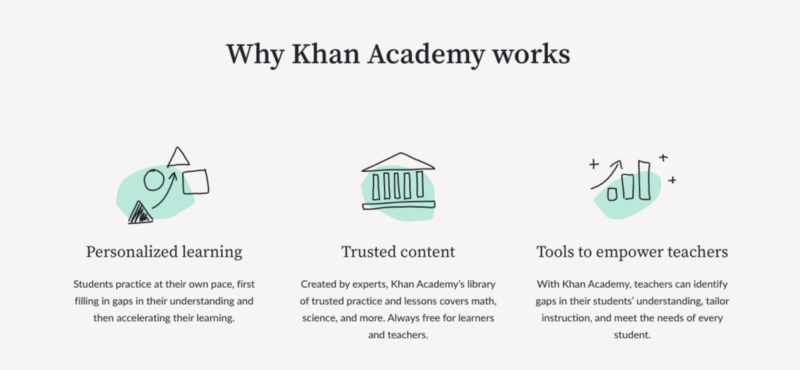
At the risk of tooting our own horn, the GetResponse landing page effectively makes use of simple benefit-focused features. It makes it really easy for users to understand exactly what they’ve got to gain when they sign up for a free trial.

Clearly stating your product’s benefits will not only help prospects know what to expect but it’s also an effective way to raise their interest in what you offer.
b. Show, don’t tell
If you’ve got a product that can be shown in action — do it.
With video rapidly becoming more crucial to marketing strategies, it can be a great way to convey your product’s value.
As with any sales pitch, the goal is to get your customer to visualize the benefits of your product, and one of the best ways to do this is through video. This helps customers see the value of your product by themselves.
Asana does this effectively with a simple product tutorial:

If you’ve got the budget, you can bring your product to life on your landing page with animation. The great thing about animation is it removes any continuity issues caused by having to click on a video. Animation also fits seamlessly into the page.
For inspiration, take a look at Muzzle. They’re a notification silencer for people using screen-sharing. The brand uses animation perfectly.
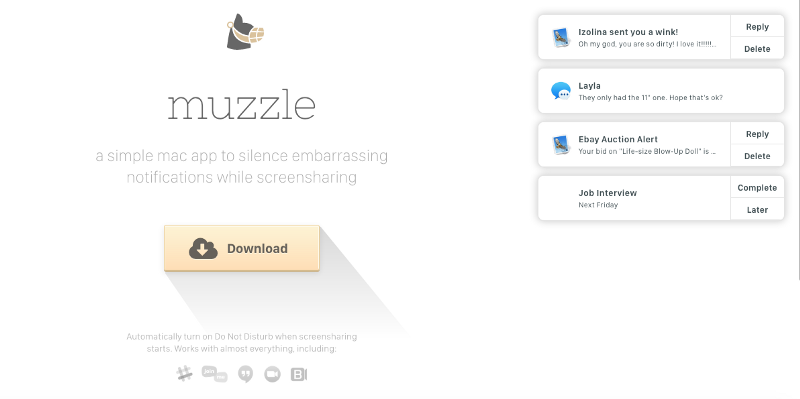
You may also enjoy:
1. How to create a high-converting landing page
3. Establish trust and credibility
Once you’ve sold your prospects on your product’s benefits, it’s time to establish proof that your brand will deliver on its promises.
It’s no secret that consumers are wary of advertisers. Research shows we’re far more discerning and suspicious than we used to be.
In fact, a study by the American Association of Advertising Agencies found that just 4% of consumers believe advertisers and marketers practice integrity.
So what does that mean for creating an effective landing page?
We’ve got to do everything we can to establish trust and credibility with our readers.
Here are two effective ways to do it:
a. Tell a story
The beauty of stories is they are all about the character’s transformation. If you can develop a story that shares the transformation your customers will experience after using your product – they’ll love you for it. Not only that, but it will also be a magnet for other prospects.
Every story has three steps — the problem, the exacerbation, and the solution. The problem phase is typically where the character experiences an issue. After several failed attempts, the issue gets worse— that’s exacerbation. Finally, the character finds the right solution, and this is a relief for them.
How do you apply this to your landing page?
Start by outlining the problem and emphasizing the pain points before you pitch your product. This way, you can get people to be more attentive. It also allows the potential consumer to marvel at the solution and feel inspired to act because they’re emotionally connected with the problem. Stories are a great way to create a connection with your customers without making your copy feel overly “salesy.” For instance, instead of blatantly trying to oversell his exercise product, The Renegade Diet captivates us by telling his transformation story.

Even if it’s his story, the transformation inspires the reader that the solution is possible.
First, the reader can empathize with his problem, “I’ve always had crappy genetics and struggled to make any gains at all.” If the prospect is also struggling with putting on muscle, this problem will feel particularly resonant.
Next, Jason presents a solution that gives the target customer hope. “Until I finally discovered the secret…doing the EXACT OPPOSITE of what every other fitness guru tells you to do”.
Finally, he inspires his audience with a transformation and makes them believe that they can do the same. “At 45, I look and feel better than ever… and I can help you achieve the same results.” Now, that’s a good sell right there!
b. Customer testimonials and brand endorsements
With research showing that 92% of people trust their peers over traditional advertising, including testimonials on your landing page is a must. It provides social proof demonstrating other people, like us, have had a positive experience and that trustworthy brands also have faith in your product.
Taster’s Club does an amazing job establishing its credibility. They have several customers explain in their own words how they benefited from the brand.

Taster’s Club did not just share reviews from individual customers. They also went further to share feedback from notable brands like Buzzfeed, Forbes, Esquire, and so on. That’s a remarkable way to make social proof work for you.
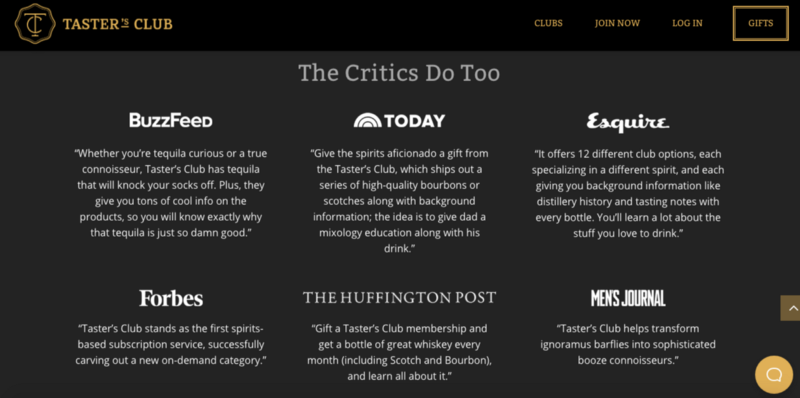
If you can include any sparkling testimonials from either loyal customers or notable brands, it will go a long way.
Tip: An important consideration when working on your testimonials is specificity. It’s a great confidence booster for prospects if you can quantify the results that existing customers have experienced. It makes it much easier to picture the potential benefits of making a purchase.
4. Create an irresistible offer
Legendary copywriter Gary Halbert once declared, “Your offer… is by far the most important element in the entire sales message.”
That’s right, the heart of the landing page comes down to the strength of your closing offer.
The reality is that if your offer doesn’t convince readers to take action – it’s failed.
But have faith, as Halbert shares, “Know this: Strong copy will not overcome a weak offer but… In many cases, a strong offer will succeed in spite of weak copy”.
Here are five ways to create an irresistible offer:
a. Limit the number of options
Limit the options you offer your readers – preferably to one.
As Barry Schwartz, author of “The Paradox Of Choice,” shares,
“The fact that some choice is good doesn’t necessarily mean that more choice is better.”
In fact, according to a study by psychologists Sheena Iyengar and Mark Lepper, too many options can make people less likely to make a choice.
So don’t overwhelm your customers with hundreds of CTAs — just offer them one.
Blue Apron’s sleek landing page does a great job of simplifying the buyer’s journey:
Even though there is a range of choices based on the different plans, notice how we’ve got to commit to choosing a plan first. There’s only one simple goal, and it’s obvious where Blue Apron wants to take us.
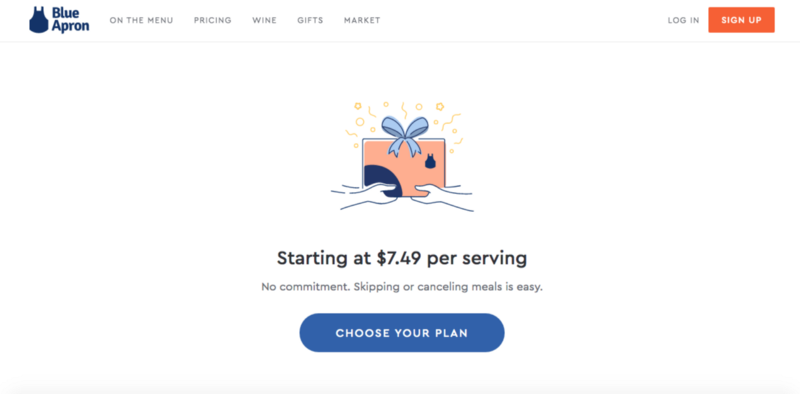
Note: Research has also shown that including several CTA’s for the same action increases conversion rates. It provides the reader with gentle encouragement to progress through the landing page.
b. Remind the reader of the key product benefits
When writing your offer, it’s a good idea to remind the reader of your biggest selling points.
Crazy Egg does a great job of emphasizing its core benefits, making signing up just a little more enticing.
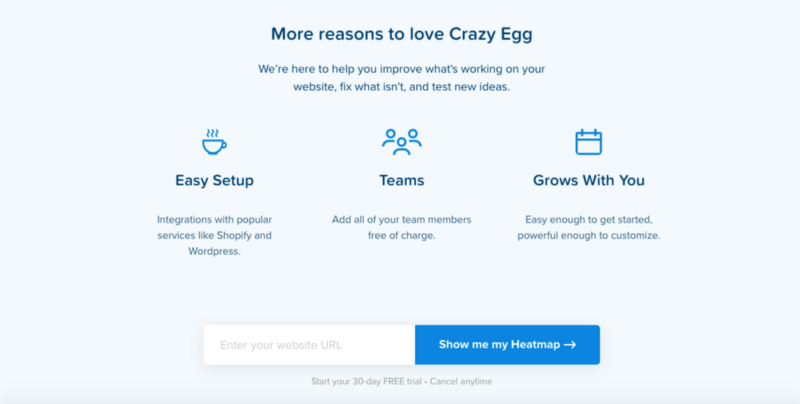
Stating your product’s unique benefit is a strategic way to remind your target customer how much they need it. Like CrazyEgg, you can aim to highlight the long-term benefits of your products. This way, you’re getting potential users to see the big picture.
Read more on the blog:
c. Anticipate objections
As with any successful sales copy, it’s essential that all of your prospect’s potential concerns be addressed before you get to the end of your landing page. Addressing these concerns helps you maximize the chance of conversions.
Wistia closes its landing page with an interesting FAQ to clear any possible issues.
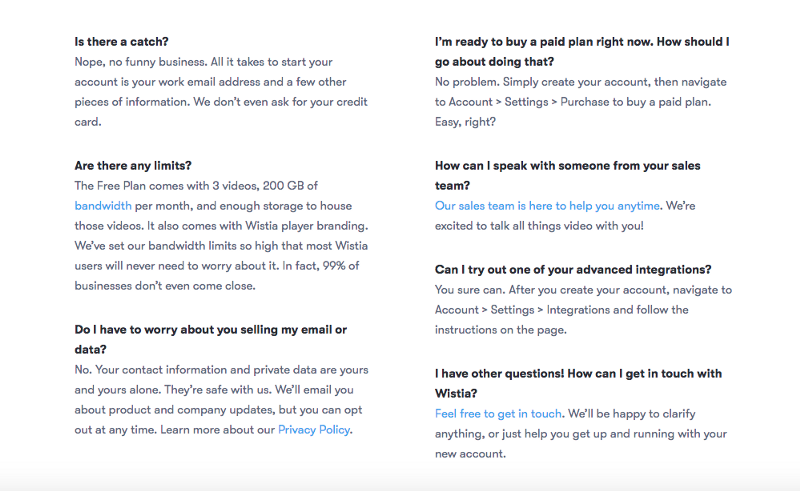
Wistia’s FAQ is clear, concise, and helpful. This might just be the action trigger for customers who may be lingering on the fence about signing up.
Another great example is Netflix. Again they’ve stuck with the classic FAQ format.

Note: FAQs are particularly important if you’ve got a complicated product and there’s the possibility of confusion. They also help you address issues not handled within the main copy.
d. Reminder of free will
In multiple studies, researchers found that simply reminding people they have free will over a decision can improve their chances of taking action.
It’s subtle, but notice how Moz applies this on their landing page:
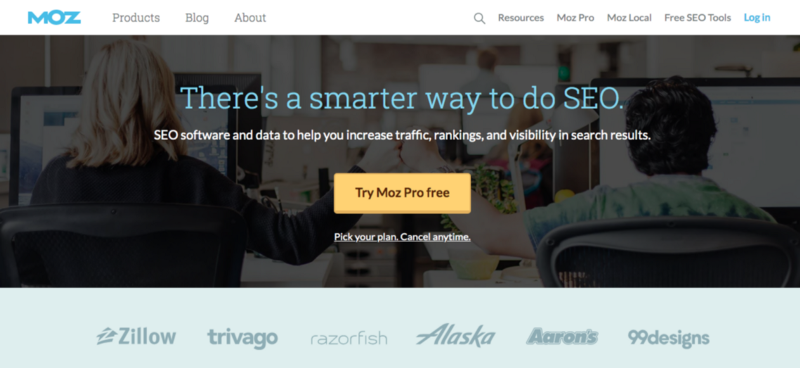
The caption “Pick your plan. Cancel anytime” reminds customers they have complete control of the purchase. Knowing they can pick the right plan for them and cancel it at any point assures prospects they have complete control over the transaction.
Give your prospects the liberty of choice as this extra assurance could be a propel to click that call to action button on your landing page.
5. Avoid landing page bloat
Picture this: your potential customers click on your ad, excited to see what awaits them on the other side. But instead of finding a sleek and straightforward landing page, they encounter a chaotic mishmash of colors, graphics, and text—all screaming for attention. Bloat like this is the nemesis of conversions.
To avoid this conversion catastrophe, prioritize simplicity and clarity in your design. Eliminate unnecessary elements that distract visitors from your core message. Ensure that every text is relevant in your copy.
Also, embrace the power of negative space to create a visually appealing and easy-to-navigate layout.
Zoho makes this work by highlighting its unique offerings with creative icons and straightforward texts. See how each element is neatly placed around the call to action button.

The rest of Zoho’s landing page also includes concise copy that aims to trigger conversions by highlighting the product’s benefits.

Every element on Zoho’s landing page serves a specific purpose— guiding visitors toward the call-to-action (CTA). This should be the case for your landing page too.
Remember, simplicity doesn’t mean blandness. It means elegance and purposeful presentation.
6. Feel free to choose long form
While concise messaging has its place, long-form content can be a potent tool for conversions when used skillfully.
Long-form copy allows you to delve deeply into the details of your product or service. It helps you showcase your product’s unique value proposition and benefits and address potential objections.
Mr. Draper is an excellent example of a long-form landing page that works.

Creating long landing pages that captivate your audience requires a delicate balance of creativity and coherence. On Mr. Draper, you’ll find a good mix of storytelling, short tutorials for using the platform, brand testimonials, FAQs, and compelling CTAs.
So, with long-form content, feel free to entwine vivid storytelling with persuasive language to keep readers engaged throughout their journey on your landing page. Of course, you want to avoid needless repetitions and forceful sales.
Ensure that your writing flows effortlessly— guiding readers from one paragraph or section to the next with ease as they explore the compelling texts that lead to your ultimate CTA.
7. Write compelling CTAs
A compelling call to action is clear and straight to the point. It’s a lot more than just a button on your landing page.
Your call to action invites prospects to take the next step in a captivating adventure. Crafting a compelling CTA requires understanding your audience’s desires and needs, so you can present them with an offer they can’t refuse.
So, instead of a mundane “Click here,” consider something more creative and specific, as Home Chef does on its landing page:

The “pick your meals” CTA button is a good step away from generic calls to action.
Appeal to the emotional side of your visitors by infusing your CTA with “power words” that evoke excitement, curiosity, or urgency.
Here’s how Waldo transformed the famous “get started” CTA by adding the word “free” to it. By doing this, Waldo gives the potential customer an exciting nudge to click the button.

Remember, the CTA is the tipping point that decides whether your visitors bounce or convert, so aim to make it irresistible.
8. Ensure the writing is simple
Complexity can be the enemy of comprehension when it comes to landing page copywriting. Your landing page should be easily digestible for visitors of all backgrounds and expertise levels. Avoid jargon or technical terms that might alienate landing page visitors.
Codecademy landing page is a good example of winning with simple writing, especially for a niche that’s quite technical:

Embrace the elegance of simplicity by using clear and concise language when you write landing page copies. Where necessary, break down complex ideas into bite-sized pieces that readers can quickly grasp.
Also, make your message relatable and memorable by using language that resonates with your audience’s specific needs.
9. Test run before launch
Creating an outstanding landing page is not a one-and-done process; it’s an ongoing journey of refinement and optimization. Before settling on a given landing page design and copy, embark on a test run using A/B testing.
Experiment with different variations of your landing page elements: headlines, CTA buttons, color schemes, and even the length of your copy.
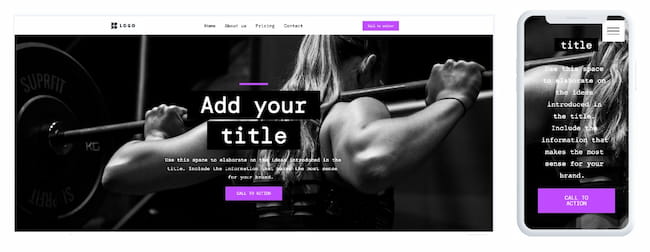
Analyze the performance of each version to gain valuable insights into what resonates most with your audience. Then, go ahead to make data-driven decisions, improving your landing page until you see better results.
Start building better landing pages
Good copy is one powerful tool that will spice up your landing page. Not only does it attract ideal customers, but it’s also what engages them and moves them into a conversion.
This post taught you nine copywriting principles that’ll elevate your landing page.
First, create an attention-grabbing headline that draws your reader in with a compelling promise. Then get your reader salivating over your amazing product benefits. Establish trust with your raving testimonials and powerful storytelling. Create an irresistible offer and avoid bloated landing pages.
Aldo, don’t hesitate to use a long-form landing page if it makes sense for your brand. Turn prospects into customers with a compelling call to action and simple writing. Finally, put your landing page to the test and tweak it for the best results.
With this guide, you have the recipe for creating a high-converting landing page. All that’s left is for you to take the first step and create a landing page of your own.
If you’re still looking for that ideal tool that’ll support you all the way, I suggest you check out the GetResponse Landing Page Creator. It offers 100+ prebuilt landing page templates and AI generative features that’ll help you create a page of your own in minutes.
And if you’d rather shop around, here’s our in-depth review of the best landing page builders available on the market.

